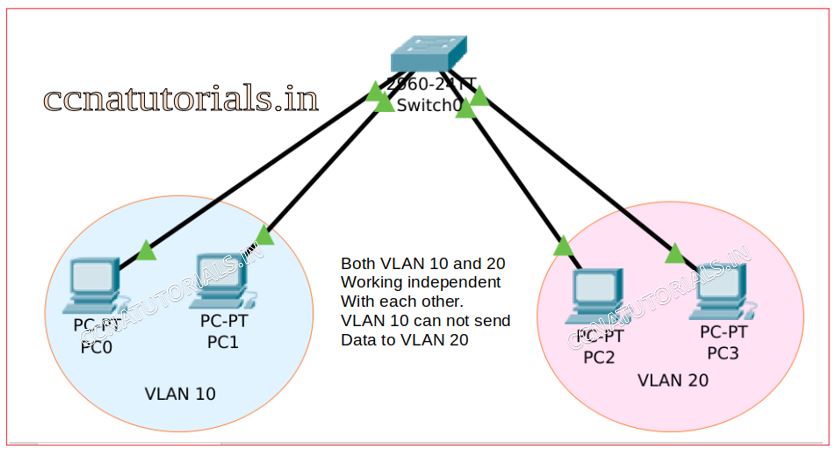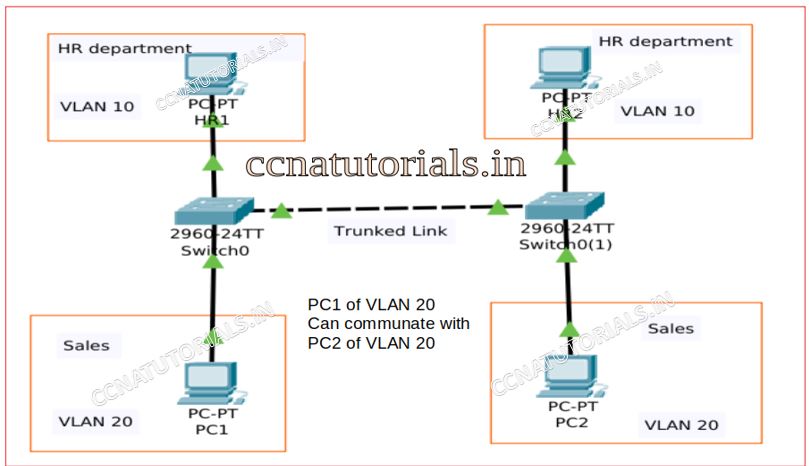In this article I describe the Frame tagging in VLAN for CCNA exam. VLAN provides multiple virtual networks in a physical network. We can break a local area network into multiple virtual networks. The devices of same virtual network can communicate with each other without interfere to other virtual network. The switchports of a switch can be used as access port or trunk port. The function of access port and trunk port are different.
The switch provide a single broadcast domain to all connected devices by default. Each port of switch creates single collision domain. VLAN breaks the broadcast domain into small broadcast domain. If we need to make communication between different VLANs then we need a router. Router have the feature to provide communication between different networks. VLAN provides the logical network within a single physical network.
VLAN basic concepts
Every switchport works on separate collision domain. We can say each device connected with a switchport remains in separate collision domain. By default all switchports of a switch works in a single broadcast domain. It can be define as all the devices working in a single LAN remains in a single broadcast domain. The big network of single broadcast domain can be divided into different small broadcast domains by creating the VLANs in the network. Every VLAN have its own broadcast domain.
Breaking the large broadcast domain into small broadcast domains provides an extra layer of security in the network. The devices of different broadcast domains can not communicate with each other. The swithports can be configured to restrict the unauthorised use by unwanted devices. Management of networking devices become easier by creating VLANs. Network administrator can monitor the small network more efficiently than a large network.
Methods of adding devices in VLAN
The devices can be added in a VLAN by two methods static and dynamic. Actually we configure the switchports for access by device with these methods. Generally static method assigned to the VLANs as it is easy and secure method. In static method we add the switchports manually to a VLAN. Suppose I assign the switchport number 4 to VLAN 10. This switchport remains assigned to VLAN unless we manually change it or assign to another VLAN. By default all switchports assigned to a single VLAN. We need to assign each port manually to the required VLAN.
The other method is dynamic assignment of swithports to VLAN according to the IP address of a device or MAC address of the device. Suppose a device connected to switchport 2 and it belongs to VLAN 20. If you change the switchport of this device from 2 to 10 then the switchport 10 automatically assigned to VLAN 20 and the device will work as it was. Dynamic method works in high end switches, in normal switch we can use static methods only.
Access port and Trunk port for VLAN basic concepts
Access ports allow a device to access the network by using the NIC or RJ45 connection. The devices connected to access ports remains in same broadcast domain. The device can access, receive and transmit the data via access port. Generally all switchports remains as access ports until we manually convert them to trunk ports.
Trunk port mode allow to transmit and receive the data of multiple VLANs. Generally endpoint devices not connected with trunk ports. The networking devices uses trunk ports to connect with each other. For example when we need to connect two switches which have multiple VLANs, the switches can be connected via trunk ports. The assignment of access ports and trunk ports are logical. A switchport mode can be changed by using the command line interface.
Frame Tagging in VLAN
Frame tagging in VLAN is most important to distinguish the data of different VLANs. We know that the VLANs created in a LAN. All computer and devices connected with a common switch can be breaks into multiple broadcast domains by creating VLANs. In a common LAN a data packet contains the source and destination mac address of device.
It is not possible to identify a data packet of a particular VLAN with destination MAC address. Frame tagging in VLAN provides the identification of data packets belongs to which VLAN. Frame tagging in VLAN helps to forward the data packet to its destination VLAN and device. When data packet required to send out of LAN IP address of destination network tagged on it by router. VLAN is independent of Router. Only a switch identifies the data packet and forward it to its destination VLAN.
Basic concept of Frame Tagging in VLAN
Remember the concept of data packet flow in LAN and internetworks. Data packets contains the destination computer physical address when forwarded to a computer within LAN. Data packets tagged an IP address when forwarded out of LAN. Here the concept is simple, now you have VLAN in place of LAN. Switch maintains a table of physical address of connected device connected to interface. We breaks the a big LAN into small VLANs. Now the LAN is not working for all devices connected to switch. Each VLAN function like a independent LAN. If you want to transfer a data packet to other VLAN, you need a router. Here the topic is about frame tagging in VLAN.

Data packets forwarded from switch to switch for same VLAN. To identify the data packets VLAN a frame tagged by the switch interface when data packet received on it. The frame tag on packet is the VLAN identity. This frame tag provides the identity of VLAN to which the packet belongs. So that the data packet can be sent to its destination within the same VLAN. The packet can be forwarded from one switch to another switch by trunked link.
Process of data flow with frame tagging in VLAN
Assume there is a VLAN name Sales in a LAN. The VLAN is configure in both switches as shown in figure. Both switches connected with the trunked link. A computer PC1 want to communicate with PC2 in same VLAN but connected with another switch. PC1 transmit a packet with the destination of PC2 to the switch1. On receiving the packet switch firstly tag a frame with the identity of VLAN sales. Switch1 search for MAC address in its local VLAN. As we can see the PC2 is connected with another switch2. Switch1 forward the packet with frame tag of vlan identity to switch 2 via the trunked link.

On receiving the packet of trunk port switch 2 identify the frame tag on the packet. Switch identifies the VLAN identity firstly. The packet handed over to the VLAN whose identity is tagged on the packet. On receiving the packet by VLAN. VLAN check the MAC address tagged on the packet and the packet forwarded to PC2. No any other VLAN interfere in it and other VLANs don’t know what happens in VLAN sales. So this is the process of data flow with frame tagging in VLAN.
In this article I describe the Frame tagging in VLAN for CCNA exam. For any query or suggestion on this article you may contact us or drop a comment below. Your suggestions are always welcome by us.






